What is the Lower Thames Crossing project?
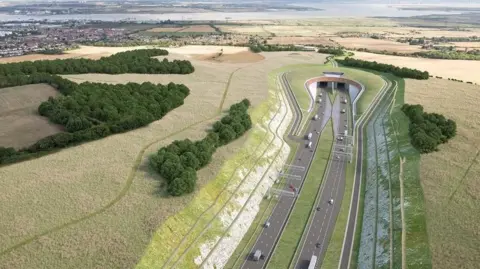 National Highways
National HighwaysSixteen years of uncertainty were brought to an end when it was announced the Lower Thames Crossing would be built.
The 14.5-mile (23km) road is due to link Essex and Kent by two tunnels running underneath the River Thames.
It will be the largest road tunnel in the UK when constructed at a cost of up to £10bn.
With work expected to start in 2026, here is everything you need to know about the project.
What has been announced?
The landmark decision was announced by the government on Tuesday, after planning consent was granted by Transport Secretary Heidi Alexander.
The road will link the A2 and M2 in Kent with the A13 and M25 in Essex, cutting out the need to use the Dartford Crossing.
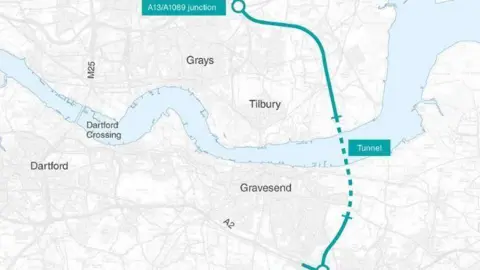 National Highways
National HighwaysAbout 2.6 miles (4.2km) of the total route will be underground, with a northbound and a southbound tunnel running next to each other beneath the Thames.
Those tunnels are going to be dug east of Gravesend in Kent and west of East Tilbury in Essex.
The announcement has been16 years in the making, with the project first mooted in 2009 and more than £1.2bn in taxpayers' money spent on planning since.
National Highways said work would begin in 2026 and be completed by 2032.
What will it mean for motorists?
The project was created to bust lengthy waiting times faced by motorists at the Dartford Crossing.
For more than 60 years, Dartford has stood as the only road east of London that crosses the Thames.
As a result, it has been one of the country's most vital trade routes that connects some of the UK's busiest ports with the rest of the country.
Yet it is now used by arguably more traffic than it was ever designed for, instead creating a bottleneck that blocks up the M25.
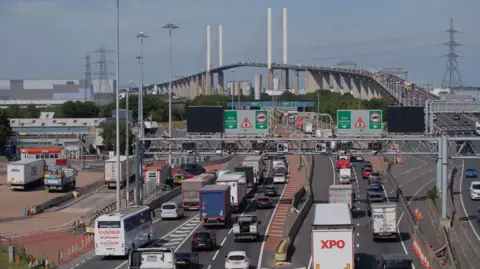 National Highways
National HighwaysNational Highways believes by offering an alternative route, the Lower Thames Crossing will ease congestion at Dartford by 20%.
Tens of millions of journeys will be made "quicker, safer and more reliable", the roads authority said.
Most of the route will have three lanes in both directions, plans have shown.
The Labour MP for Dartford, Jim Dickson, said the Lower Thames Crossing would "finally deliver a solution to the traffic chaos" faced by motorists.
The Port of Tilbury has also welcomed the project's approval, saying it will "improve connectivity".
How will it be funded?
How exactly the crossing will be paid for is a hot topic in the aftermath of Tuesday's announcement.
National Highways initially expected it would cost £8.3bn, but now believes that price could rise to £10bn.
As of Tuesday, the latest estimation was a £9bn expenditure.
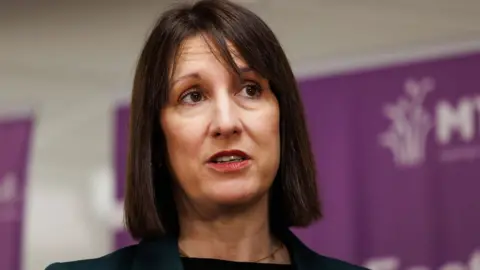 PA Media
PA MediaThe government has not confirmed how it will fund works, although it is understood private finance options are being explored.
This has previously been confirmed by Chancellor Rachel Reeves, who said in January: "We will work with the private sector to deliver the infrastructure that our country desperately needs".
Until a backer has been secured, uncertainty will remain over the project's viability.
More than £1.2bn has already been spent prior to the plan's approval, with blueprints drawn up and consultations held.
What has been the reaction?
The BBC spoke to those living in south Essex towns affected by the Lower Thames Crossing plan.
Donald Jackson, 77, said he thought the project would be a positive for the area.
"If the QE2 Bridge stops, it causes massive disruption around here, everything blocks up and it clogs everywhere," the retired carpenter said.
"If there's a lower crossing, that would ease congestion."
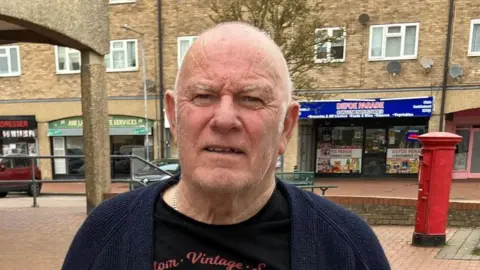 Nadira Tudor/BBC
Nadira Tudor/BBCTara Matthews, 30, shared concerns about the impact work would have on wildlife.
"Nature is close to by heart and I'm worried," she said.
"Are we going to lose the stag beetles, the slow worms and all the wildlife we've got around here?"
Colin Boughen, a social worker, added: "The air quality is going to deteriorate.
"I've got a lot of breathing problems and I think it's just going to exacerbate it."
Analysis by Andrew Sinclair, BBC East of England political editor
There has been talk of a Lower Thames Crossing for years.
It has been deeply controversial and very expensive, which is probably why previous governments have been in no hurry to give it the go-ahead.
The fact this government has made the decision is a major step forward.
The chancellor will almost certainly hold up this project in her Spring Statement as proof that Labour is prepared to take tough decisions to drive growth and benefit the economy.
But there is still the not insignificant matter of working out who will pay for it - and how.
The government says it is "exploring all funding options" and is known to be keen to get private finance to pay for a large part of this project.
Until a backer is found, there will be uncertainty about when or even if this project can become reality.
That will frustrate those who say this crossing is needed now and those living along the proposed route.
Follow Essex news on BBC Sounds, Facebook, Instagram and X.
